
Ancistrocheirus lesueurii, the sharpear enope squid, is the only species in the genus Ancistrocheirus and family Ancistrocheiridae. With a mantle length of 25 cm, this moderately sized squid may be found throughout the tropical and subtropical oceans. They tend to be found at mesopelagic depths.

The Mastigoteuthidae, also known as whip-lash squid, are a family of small deep-sea squid. Approximately 20 known species in six genera are represented, with members found in both the mesopelagic and bathypelagic zone of most oceans. Originally described by Verill in 1881, it was later lowered by Chun (1920) to a subfamily (Mastigoteuthinae) of the Chiroteuthidae. However, Roper et al. (1969) raised it back to the family level, and this has not been changed since. The taxonomy of this family is extremely unstable, and there have been at times one genus, two genera and four subgenera(Salcedo-Vargas & Okutani, 1994), two genera and several 'groups', five genera and one species with an uncertain placement, or six genera.
Liguriella is a genus of glass squids, the genus is probably monotypic, the only species being Liguriella podophthalma. The other named species Liguriella pardus, which was described by S. Stillman Berry in 1916, is cited as a taxon inquirendum but it is suggested that there may be in fact more than one species and there are species yet to be described.

Bathothauma lyromma, the lyre cranch squid, is a highly modified species of glass squid from the family Cranchiidae with a distribution which encompasses most of the world's oceans from the tropics to high latitudes.
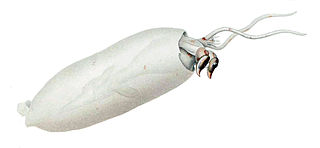
Sandalops melancholicus, the sandal-eyed squid or melancholy cranch squid, is a small species of glass squid. It is known to reach a mantle length of 11 cm. It is distributed in the tropical and subtropical oceans around the world. It is the only species in the genus Sandalops but some authorities suggest that this may be a species complex rather than a monotypic genus.

Liocranchia is a genus of glass squid from the family Cranchiidae. They are moderate-sized with a long, spindle-shaped mantle which tapers to a point at the rear and they can attain mantle lengths of 250 mm. The species in Liocranchia have a cosmopolitan distribution in tropical and subtropical oceans although it has been suggested that on especies, Liocranchia reinhardti is associated with land masses. In seas off Hawaii waters L. reinhardti undergoes vertical migrations while L. valdiviae occurs in deep water is sedentary. They are eaten by many oceanic predator species.

Helicocranchia pfefferi, the banded piglet squid, is a small squid of the genus Helicocranchia. Adults of this species are mesopelaegic.

Idioteuthis cordiformis is a species of whip-lash squid found in tropical regions of the west Pacific Ocean. The species is commonly known as the 'love-heart squid' because the species name cordiformis is Latin for 'heart shaped'. Recently, this species has been found to consume small birdbeak dogfish.

Histioteuthis reversa, commonly known as the reverse jewel squid or the elongate jewel squid, is a species of cock-eyed squid, so called because the eyes are dissimilar. It occurs at moderate depths in the Atlantic Ocean and Mediterranean Sea and is also known from the Indian Ocean.
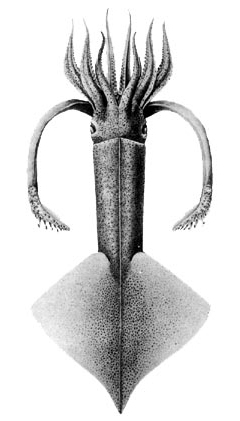
Onychoteuthis is a genus of squid in the family Onychoteuthidae. The type species is Onychoteuthis bergii. While the genus is found worldwide in tropical and subtropical oceans, they can also occur in the North Pacific Ocean. There were previously considered to be four species in the genus but there are now considered to be roughly 10. These squid are frequently observed in the surface waters at night and they are often caught using dipnet at nightlight stations. The young squid are usually the only specimens captured using standard midwater trawls, the older squid are apparently able to avoid the trawls. They can, however be collected from the air as individuals are able to leap high out of the water, sometimes even landing on the deck of a ship.

Enoploteuthis is a genus of squid in the family Enoploteuthidae. The species of Enoploteuthisare most easily recognised by having a larger tail when compared to the other genera in the Enoploteuthidae. The tail's size is emphasised not having the fins extending along its sides. In related genera there is a narrow extension of the fins along the tail. Other characteristics include the presence of suckers on the distal portion of arms IV where there at no photophores present; the tentacular club has two rows of hooks and no marginal suckers; on the buccal crown there are typical chromatophores on the aboral surface but on the oral surface there may be some light skin pigmentation. They have 9-10 photophores on the eye and they have complex photophores in the skin. In the females the Spermatangia receptacles are at the posterior junction of muscles used to retract the funnel and the muscles which retract the head. Enoploteuthis differs from other genera of the Enoploteuthidae in having two rather than three types of photophores in its integument and these are on the ventral areas of the head, funnel and mantle. All species of Enoploteuthis which have been studied have the most complex type of photophoreand seems to be a distinctive characteristic of this genus. Enoploteuthis contains the largest species in the family, attaining a mantle length of 130mm.
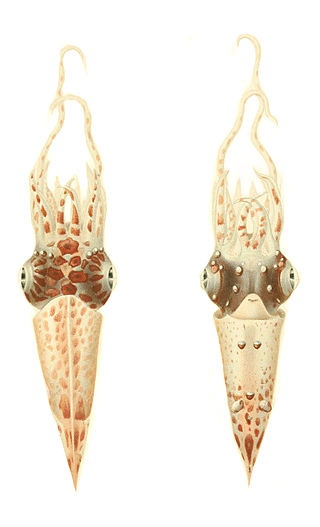
Pterygioteuthis giardi is a species of squid in the family Pyroteuthidae. It is known as the roundear enope squid. The specific name honors the French zoologist and marine biologist Alfred Mathieu Giard (1846-1908).

Illex coindetii, commonly known as the southern shortfin squid or broadtail shortfin squid, is a species of neritic squids in the family Ommastrephidae. They are found in the Mediterranean Sea and on both sides of the north Atlantic Ocean.

Teuthowenia megalops, sometimes known as the Atlantic cranch squid, is a species of glass squid from the subarctic and temperate waters of the northern Atlantic Ocean. They are moderately sized squid with a maximum mantle length of 40 cm (16 in). Their very large eyes are the source for the specific name megalops. Like other members of the genus Teuthowenia, they are easily recognizable by the presence of three bioluminescent organs (photophores) on their eyeballs.

Taonius belone is a glass squid belonging to the genus Taonius from the family Cranchiidae. It occurs in the northern subtropical and in the tropical or equatorial waters of the Pacific and Indian Oceans.
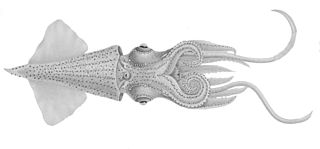
Enoploteuthis leptura, the hooked enope squid, is a species of squid from the family Enoploteuthidae. It is the type species of the genus Enoploteuthis, which is in turn the type genus of the Enoploteuthidae.
Lampadioteuthis megaleia is a small, colorful squid, the only species in the only genus in the monotypic family Lampadioteuthidae. It is sometimes known as the wonderful firefly squid. It was formerly classified in the family Lycoteuthidae, but differs from them mainly by having a hectocotylus in the males and by the possession of a rostrum on the gladius.
Eucleoteuthis is a monotypic genus of squid from the family Ommastrephidae; the only species is Eucleoteuthis luminosa, the striped flying squid or luminous flying squid.
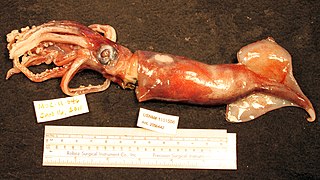
Ornithoteuthis antillarum, the Atlantic bird squid, is a species of flying squid from the family Ommastrephidae which is found in the warmer waters of the Atlantic Ocean. This species is an important component of the diet of many species of fish and of cetaceans. It is taken as a bycatch in fisheries but has the potential to be commercially important if appropriate fishing methods can be developed.
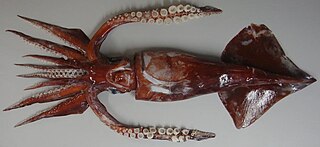
The Antarctic flying squid is a species of squid from the subfamily Todarodinae of the family Ommastrephidae, a family of pelagic squid from the order Oegopsida. It has a circumglobal distribution in the seas around the lower latitudes of the Southern Oceans.

















